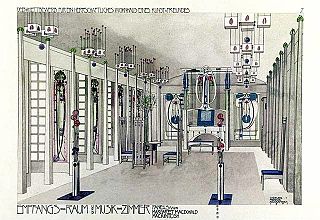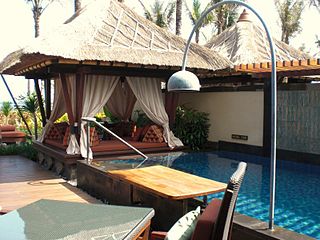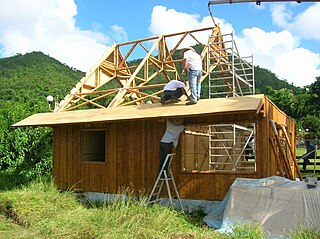Related Research Articles

An architect is a person who plans, designs, and oversees the construction of buildings. To practice architecture means to provide services in connection with the design of buildings and the space within the site surrounding the buildings that have human occupancy or use as their principal purpose. Etymologically, the term architect derives from the Latin architectus, which derives from the Greek, i.e., chief builder.

Landscape architecture is the design of outdoor areas, landmarks, and structures to achieve environmental, social-behavioural, or aesthetic outcomes. It involves the systematic design and general engineering of various structures for construction and human use, investigation of existing social, ecological, and soil conditions and processes in the landscape, and the design of other interventions that will produce desired outcomes.

Interior architecture is the design of a building or shelter from inside out, or the design of a new interior for a type of home that can be fixed. It can refer to the initial design and plan used for a building's interior, to that interior's later redesign made to accommodate a changed purpose, or to the significant revision of an original design for the adaptive reuse of the shell of the building concerned. The latter is often part of sustainable architecture practices, whereby resources are conserved by "recycling" a structure through adaptive redesign.

Sustainable architecture is architecture that seeks to minimize the negative environmental impact of buildings through improved efficiency and moderation in the use of materials, energy, development space and the ecosystem at large. Sustainable architecture uses a conscious approach to energy and ecological conservation in the design of the built environment.

The architecture of Indonesia reflects the diversity of cultural, historical, and geographic influences that have shaped Indonesia as a whole. Invaders, colonizers, missionaries, merchants, and traders brought cultural changes that had a profound effect on building styles and techniques.

John Hardy, established in Bali in 1975, creates artisan handcrafted jewelry. Each of John Hardy’s distinctive collections conveys evocative symbolism and honors the transmission of creative energy from the artist to the wearer. Since inception, the company has been deeply rooted in the essential values of community, artisanship, and sustainability.
The Instituto de Tecnologia Intuitiva e Bioarquitetura, or TIBÁ, is an eco-centre located in the coastal jungle of Brazil, dedicated to demonstrating and teaching sustainable development and "barefoot" construction techniques.

WOHA is a Singaporean multinational architectural industrial design firm. First established in 1994 by Wong Mun Summ and Richard Hassell, its name is derived from the initial letters of the founders’ surnames. Based out of Singapore, the firm has built and designed dozens of projects throughout the Asia-Pacific, including residential towers, public housing estates, mass transit stations, hotels and cultural institutions.

Sheila Sri Prakash is an architect and urban designer of Indian origin. She is the founder of Shilpa Architects and is the first woman in India to have started and operated her own architectural practice.
Atelier One is a British structural engineering company, established in 1989 and based in London. The company has collaborated with architects, designers and artists, and has been described as 'the most innovative engineering practice in the UK.'
Environmentally sustainable design is the philosophy of designing physical objects, the built environment, and services to comply with the principles of ecological sustainability and also aimed at improving the health and comfort of occupants in a building. Sustainable design seeks to reduce negative impacts on the environment, the health and well-being of building occupants, thereby improving building performance. The basic objectives of sustainability are to reduce the consumption of non-renewable resources, minimize waste, and create healthy, productive environments.

Rumah adat are traditional houses built in any of the vernacular architecture styles of Indonesia, collectively belonging to the Austronesian architecture. The traditional houses and settlements of the several hundreds ethnic groups of Indonesia are extremely varied and all have their own specific history. It is the Indonesian variants of the whole Austronesian architecture found all over places where Austronesian people inhabited from the Pacific to Madagascar each having their own history, culture and style.

Anna Heringer is an acclaimed architect known for her innovative approach to sustainable architecture, particularly in the realm of earthen construction. Her work is characterized by a deep respect for local materials and techniques, as well as a commitment to community engagement and empowerment. Heringer's projects span the globe, from Bangladesh to Austria, and have garnered international recognition for their beauty, functionality, and sustainability, most notably the METI Handmade School in Rudrapur, Bangladesh.

The METI Handmade School, a primary school for 168 students located in Rudrapur in Dinajpur district of Bangladesh, was built with the assistance of local craftsmen making use of traditional materials, primarily mud and bamboo. An example of sustainable architecture, the project received the Aga Khan Award for Architecture in 2007 for its simple, humane approach and beauty, and for the level of cooperation achieved between architects, craftsmen, clients and users.

Green School Bali is a private and international pre-kindergarten to high school located along the Ayung River near Abiansemal, Badung Regency, Bali, Indonesia.

Balinese architecture is a vernacular architecture tradition of Balinese people that inhabits the volcanic island of Bali, Indonesia. Balinese architecture is a centuries-old architectural tradition influenced by Balinese culture developed from Hindu influences through ancient Javanese intermediary, as well as pre-Hindu elements of native Balinese architecture.

Bamboo construction involves the use of bamboo as a building material for scaffolding, bridges, houses and buildings. Bamboo, like wood, is a natural composite material with a high strength-to-weight ratio useful for structures. Bamboo's strength-to-weight ratio is similar to timber, and its strength is generally similar to a strong softwood or hardwood timber.

Delia Narayan "Didi" Contractor was an American artist and builder. A self-taught architect, she is known for her work on the vernacular traditions in India, using adobe, bamboo and stone for materials. She was a recipient of the Nari Shakti Puraskar, India's highest civilian award for recognising the achievements and contributions of women.
The Environmental Bamboo Foundation is an Indonesian nonprofit organization involved in sustainable forestry management, specifically by using local bamboo plantations as a way to preserve tropical forest resources. The organization has partnerships with numerous civil and academic institutions as well as government institutions including the Indonesian Ministry of Environment and Forestry. A manufacturing company, Indobamboo, was set up to oversee the production of bamboo products stemming from the organization's activities. The organization has been represented at recent climate conferences, notably including recent United Nations COP conferences COP21, COP23, and COP26. In 2021, the foundation's manufacturing company Indobamboo secured a €350,000 grant from the Dutch Fund for Climate and Development (DFCD) and WWF to set up a bamboo manufacturing factory in Flores, Indonesia.
Heather Dubbeldam, OAA, FRAIC, LEED AP, WELL AP is a Canadian architect based in Toronto. She received the 2016 Prix de Rome in Architecture for her research on sustainable housing. In 2003, Dubbeldam founded Dubbeldam Architecture + Design a midsized multidisciplinary firm. Prior to starting her own firm, she worked for Kuwabara Payne McKenna Blumberg (KPMB), where she gained her architectural license. Beyond architectural practice, Dubbeldam contributes to the architectural community as a volunteer on various boards. These boards include: Building Equality in Architecture Toronto (BEAT), Twenty + Change, and the Design Industry Advisory Committee (DIAC). Her volunteering also includes affiliations with multiple architectural schools as a critic and advisory council member. In 2024, Heather was selected by the Royal Architectural Institute of Canada (RAIC) to receive the King Charles III Coronation Medal for Architecture, recognizing her contributions to the profession and the community.
References
- ↑ "Elora Hardy's 'Magical' Bamboo Buildings -". World-Architects. Retrieved 2018-11-15.
- ↑ "Woman Quits Job to Build Sustainable Bamboo Homes In Bali". Bored Panda. Retrieved 2018-11-15.
- 1 2 3 Dalton, Bill (2013-05-07). "Elora Hardy: Bamboo Entrepreneur". Indonesia Expat. Retrieved 2019-01-09.
- 1 2 "Elora Hardy". www.archdaily.com. Retrieved 2018-11-15.
- ↑ "Green Village, Bali: Elora Hardy's treehouses from dreams". Stuff. 22 October 2017. Retrieved 2019-01-09.
- ↑ "Is Bamboo the Sustainable Building Material of the Future?". Vogue. Retrieved 2018-11-15.
- ↑ "Elora Hardy | MIT Architecture". architecture.mit.edu. Archived from the original on 2019-04-01. Retrieved 2018-11-15.
- ↑ Hardy, Elora. "Elora Hardy | Speaker | TED" . Retrieved 2018-11-15.
- ↑ "Creative ignition: A recap of Session 7 of TED2015". TED Blog. 2015-03-18. Retrieved 2018-11-15.
- ↑ "NOMADSofORIGIN l IBUKU".
- ↑ Dalton, Bill (2013-05-07). "Elora Hardy: Bamboo Entrepreneur". Indonesia Expat. Retrieved 2020-12-07.
- 1 2 Hardy, Elora (12 May 2015), Magical houses, made of bamboo , retrieved 2020-12-07
- ↑ "Penny BERTON Obituary (1948 - 2019) - Toronto, ON - The Globe and Mail". Legacy.com .
- ↑ Williams, Caroline (July 2012). "One and only you". New Scientist. 215 (2875): 32–36. Bibcode:2012NewSc.215R..32W. doi:10.1016/s0262-4079(12)61956-3. ISSN 0262-4079.
- ↑ Lederman, Marsha (25 March 2015). "Building the future of architecture with culture and natural materials - The Globe and Mail". The Globe and Mail.
- 1 2 Annie Kelly. "A Tree House in Bali". New York Magazine. October 14, 2013. https://advance-lexis-com.hollins.idm.oclc.org/api/document?collection=news&id=urn:contentIt em:59MS-M931-DYWJ-M4C3-00000-00&context=1516831
- 1 2 Umorina, Z. “Peculiarities of Natural Technology Application in Architecture” IOP Conference Series: Materials Science and Engineering 262 (2017): 012125. doi : 10.1088/1757-899x/262/1/012125
- 1 2 Jacobs, Neil. "John and Elora Hardy: Green School and Ibuku." Hospitality Design 39, no. 10 (2017): 132
- 1 2 Maikol, Solanilla Medina Yor, Shuvalov Vasily Maksimovich, Bykova Galina Ivanovna, and Sultanova Ainur. "Bamboo Structures for Modern Sustainable Architecture." (2020). http://isvshome.com/pdf/ISVS_7-3/ISVS_ej_7.3.3_Solanilla_%20Final.pdf.
- ↑ Itzkowitz, Laura (24 October 2017). "Is Bamboo the Sustainable Building Material of the Future?". Vogue. Retrieved 2020-12-07.
- ↑ Durbanova, Anna (August 15, 2016). "Building with Sustainability in Mind". Impakter. Retrieved December 7, 2020.
- ↑ "Rethinking Materials: Ellora Hardy, A Non-Architect Creating Alternatives - Rethinking The Future". Rethinking The Future. 2020-03-13. Retrieved 2020-12-07.
- ↑ "Construction and the Environment". First In Architecture. 2019-01-22. Retrieved 2020-12-07.
- ↑ "6 Famous Architects Share their Top Sustainable Design Tips". TerraMai. 2018-10-09. Retrieved 2020-12-07.
- ↑ Williams, Gisela. "If You Build It." Vogue (New York) 202, no. 11 (2012): 150
- ↑ Suqi, Rima. "Bamboo Takes a Bow." The New York Times (New York, N.Y), 2014